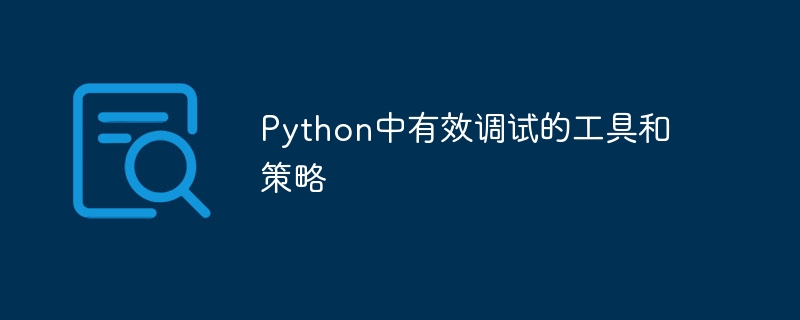Home >Backend Development >Python Tutorial >Tools and Strategies for Effective Debugging in Python
Tools and Strategies for Effective Debugging in Python
- PHPzforward
- 2023-08-27 08:13:06863browse

In this tutorial, we will explore various tools and strategies that can significantly improve your debugging experience in Python. As a Python developer, it is crucial to understand debugging techniques in order to identify and fix problems efficiently. In this article, we'll take a deep dive into techniques and methods for effectively debugging Python.
Debugging is an essential part of the software development process. It involves identifying and resolving errors or bugs in your code. Through the tools and strategies we'll discuss, you'll be able to solve complex problems and improve your coding skills.
Section 1: Integrated Development Environment (IDE)
In this section, we will focus on how to use an integrated development environment (IDE) to aid the debugging process. IDEs provide powerful tools and features that simplify the task of identifying and resolving errors in Python code. Here's a step-by-step guide on how to leverage your IDE for effective debugging:
Start by choosing the integrated development environment (IDE) that best suits your needs. Popular choices include PyCharm, Visual Studio Code, and Jupyter Notebook.
Install the IDE of choice and set up a new project or open an existing project.
In the IDE, navigate to the section of code where you suspect there may be an error.
Set breakpoints at specific lines of code where you want program execution to pause.
Run the program in debug mode and observe its execution. When your program hits a breakpoint, it pauses, allowing you to inspect variable values, step through code, and trace the flow of execution.
Leverage features such as variable observers, call stack inspections, and interactive consoles to gain deeper insight into your program's state and behavior.
Once you have identified the problem, make the necessary code changes and retest until the problem is resolved.
Example
This is a sample code snippet:
def calculate_sum(a, b):
result = a * b # Potential bug: multiplication instead of addition
return result
x = 5
y = 10
z = calculate_sum(x, y)
print("The sum is:", z)
As can be seen from the above output, the program mistakenly multiplies `a` and `b` instead of adding them. By leveraging the debugging capabilities of the integrated development environment (IDE), we can easily identify and fix this error.
Section 2: Logging and debugging statements
Another effective strategy for Python debugging is to use logging and debugging statements. These statements allow you to print out specific information during program execution, providing insight into the state of variables, function calls, and control flow. Let’s explore this approach:
Identify the portion of the code that you suspect has a bug or unexpected behavior.
Insert relevant logging statements using the "print()" function or a dedicated logging library (such as the built-in "logging" module).
Output relevant information at strategic points in the code, such as variable values or function output.
Run the program and examine the generated log statements to gain insight into the program's execution flow and variable state.
Analyze log statements to identify any unusual or unexpected behavior.
Make necessary code modifications based on the information obtained and retest the program.
Example
Consider the following code snippet:
import logging
def calculate_product(a, b):
logging.debug(f"Calculating the product of {a} and {b}")
result = a * b
logging.debug(f"The product is {result}")
return result
x = 5
y = 10
z = calculate_product(x, y)
print("The product is:", z)
In the above code snippet, we use the "logging" module to output information about the calculation process. By inspecting log statements, we can trace the flow of execution and ensure that the program runs as expected.
Section 3: Interactive Debugger and PDB
Interactive debuggers, such as the Python Debugger (PDB), provide an interactive environment to diagnose and fix problems in your code. PDB provides a command line interface that allows you to interactively browse your code, set breakpoints, and inspect variables. Here's how to leverage PDB for effective debugging:
Find out the problematic parts of the code.
Import the `pdb` module and insert a `pdb.set_trace()` statement at the desired location to start a debugging session.
Run the program and it will pause at the `pdb.set_trace()` statement.
Use various PDB commands to browse the code, inspect variables, and step through the code.
Inspect the values of variables at different breakpoints to identify any unexpected behavior.
Modify the code as needed, retest and continue debugging until the problem is resolved.
Example
Consider the following code snippet:
import pdb
def calculate_division(a, b):
result = a / b
return result
x = 10
y = 0
pdb.set_trace()
z = calculate_division(x, y)
print("The result is:", z)
When running the above code, the program will pause at the `pdb.set_trace()` statement. You can then use PDB commands, such as `next`, `step`, and `print`, to navigate and inspect the code. PDB provides you with a powerful toolset for understanding and fixing problems in Python programs.
in conclusion
In this tutorial, we explored various tools and strategies for effective debugging in Python. Integrated development environments (IDEs), logging and debugging statements, and interactive debuggers such as PDB can significantly help you identify and resolve errors in your code. By leveraging these techniques, you can simplify the debugging process, enhance your understanding of program behavior, and become a more effective Python developer. Remember to choose the method that best suits your workflow and make the most of the tools available to you.
The above is the detailed content of Tools and Strategies for Effective Debugging in Python. For more information, please follow other related articles on the PHP Chinese website!

